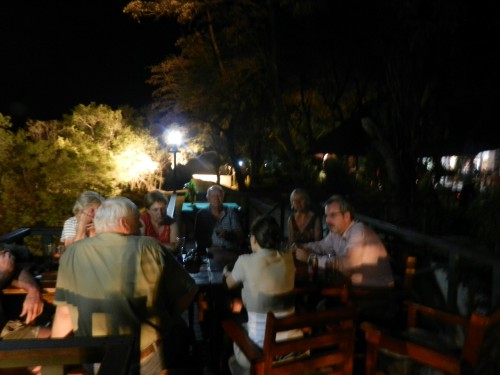
I am up in Caprivi this week – the thin finger of land in Namibia’s extreme north east that points into the heart of southern Africa and marks the coming together of Namibia, Zambia, Botswana, Angola and Zimbabwe in a tight bunch of border posts.
My visit has proven a fantastic learning experience and given me insight into this unique and beautiful corner of Namibia and the difficulties it faces with high poverty rates, regular flooding/droughts, and practical issues of getting services to reach inaccessible rural communities.
Meetings with the Regional Governor, Mayor of provincial capital Katima Mulilo, local politicians and development workers, including one of Namibia’s two Cheshire Homes for the disabled, have helped me piece together a picture of both the challenges and opportunities that this strategically located region offers. A British firm, Capita Symonds, has recently completed a plan for the redevelopment of Katima Mulilo airport, which is set to expand, and it has been great to add British commercial interests to our list of things to follow in this fascinating region.
Enhanced transport routes have helped to boost the role of Caprivi as a vital transit route in recent years. The completion of the Sesheke bridge across to Zambia has provided a much needed link to that country’s rich copper belt and the DRC – down and across to Namibia’s main coastal port of Walvis Bay – via the Trans Caprivi Corridor.
As part of my ongoing UK mapping exercise, I also reached out to the British community in the area and met with a number of Brits on the banks of the Zambezi River to find out what they were up to and how they were contributing to Namibian life so far north. One works at Katima’s Vocational Training College – a much needed institution that is helping to plug the skills gap in the area – and the others worked in tourism and conservancy.
There is plenty of stunning scenery in this part of the country to entice British tourists, although only a fraction of the 27,000 Brits that visited Namibia last year are believed to have ventured so far north. Wildlife abounds on the shores of the Zambezi, providing a rich array of species to draw bird enthusiasts as well as game watchers to this far flung narrow strip of land that was created in 1890 in a land swap between colonial powers. Britain exchanged the corridor to the Germans for the island of Zanzibar, amongst other assets. The Germans soon discovered that it failed to provide their desired navigable link from German South West Africa to their territories in eastern Africa due to the intervening rapids of the Victoria Falls further upstream.
Access difficulties have long beset the area. On a visit to Ngoma Primary School, I learnt about a different version of this problem from the Principal, Charles Kamwi, who told me that some of the 333 children who attended the school on the border with Botswana sometimes had to face elephants on their daily walk to school. Not an atypical problem for rural African learners.
Whilst I was unable to help with wildlife issues, I had chosen to visit the school to see the fruits of a project co-funded by the British, Finnish and Austrian governments to help with its feeding programme. The project supplies fuel efficient biomass stoves to remote schools in rural Namibia. The specially designed stoves use significantly less wood than traditional open fire cooking methods and produce less smoke resulting in wider health benefits.
The stove provided to Ngoma Primary heats two large cooking pots to produce a daily ration of maize porridge for up to 200 orphaned and vulnerable children to eat at their mid-morning break. We watched as two parent volunteers prepared the porridge and learners queued up patiently in the sun outside the kitchen to receive their bowl, which marked the first meal of the day for many.
During the process, we could clearly see how the special design of the oven enclosed the flame and surrounded the pot to heat it up from the bottom and spread heat evenly to produce a better quality of porridge from the government supplied maize meal. It also protected the cook from being burnt by a high temperature metal pot and open flames.
The project was a good example of donor support being used to maximise the effect of a government service and deliver a great result for a community on the ground.
Other stops on the trip include visits to meet UK funded HIV-Aids education advisory workers (via VSO), conservancy projects and the Namibia Red Cross in action. In the meantime, do get out your travel books and read up on ways to reach this fascinating and stunning region. It is well worth seeing.
